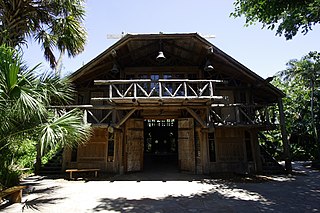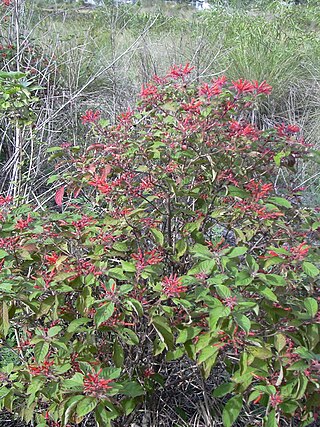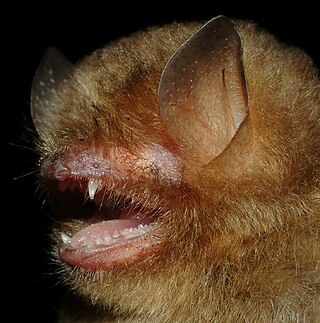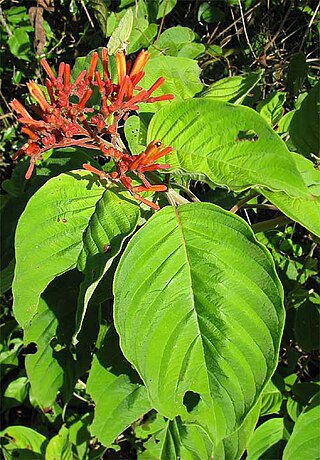
The bee hummingbird, zunzuncito or Helena hummingbird is a species of hummingbird, native to the island of Cuba in the Caribbean. It is the world's smallest bird.

The McKee Botanical Garden is a non-profit, subtropical botanical garden in Vero Beach, Florida. It is located at 350 U.S. Highway 1, Vero Beach, Florida.

The red-naped ibis also known as the Indian black ibis or black ibis is a species of ibis found in the plains of the Indian Subcontinent. Unlike other ibises in the region it is not very dependent on water and is often found in dry fields a good distance away from water. It is usually seen in loose groups and can be told by the nearly all dark body with a white patch on the shoulder and a bare dark head with a patch of crimson red warty skin on the crown and nape. It has a loud call and is noisy when breeding. It builds its nest most often on the top of a large tree or palm.

Cupaniopsis is a genus of about 67 species of trees and shrubs of the soapberry family, Sapindaceae. They grow naturally in New Guinea, New Caledonia, Australia, Torres Strait Islands, Fiji, Samoa, Sulawesi, Micronesia. Many species have been threatened with extinction globally or nationally, with official recognition by the International Union for Conservation of Nature (IUCN) and several national and state governments.

Hamelia patens is a large perennial shrub or small tree in the family Rubiaceae, that is native to the American subtropics and tropics. Its range extends from Florida in the southern United States to as far south as Argentina. Common names include firebush, hummingbird bush, scarlet bush, and redhead. In Belize, this plant's Mayan name is Ix Canaan and is also known as "Guardian of the Forest".

The papillose woolly bat is a species of vesper bat in the family Vespertilionidae. It is found in Brunei, India, Indonesia, Malaysia, and Vietnam.

The dusky eagle-owl is an owl species in the family Strigidae that is widespread in South and Southeast Asia. The type specimen used to describe the species was collected on the Coromandel Coast, which was used for the specific epithet. It is listed as Least Concern on the IUCN Red List. The species's extent of occurrence is estimated at 9,250,000 km2 (3,570,000 sq mi). However, volunteer generated databases such as eBird.org suggest that the available extent of occurrence is a vast over-estimate.

Branchinecta is a genus of crustacean in family Branchinectidae. It includes around 50 species, found on all continents except Australia. Branchinecta gigas, the giant fairy shrimp, is the largest species in the order, with a length of up to 10 centimetres (4 in), and Branchinecta brushi lives at the highest altitude of any crustacean, at 5,930 metres (19,460 ft), a record it shares with the copepod Boeckella palustris. A new genus, Archaebranchinecta was established in 2011 for two species previously placed in Branchinecta.
Berberis papillosa is a species of plant in the family Berberidaceae. It is endemic to Ecuador. Its natural habitats are subtropical or tropical high-altitude shrubland and subtropical or tropical high-altitude grassland.

Hamelia is a genus of flowering plants in the coffee family, Rubiaceae. The name honors French botanist Henri-Louis Duhamel du Monceau (1700–1782).

Miconia papillosa is a species of plant in the family Melastomataceae. It is endemic to Ecuador. Its natural habitats are subtropical or tropical moist montane forests and subtropical or tropical high-altitude grassland.
The lenis woolly bat is a species of bat in the family Vespertilionidae. It is found in South and Southeast Asia.

Aeolidia papillosa, known as the common grey sea slug, is a species of nudibranch in the family Aeolidiidae.
Lyndley Alan Craven was a botanist who became the Principal Research Scientist of the Australian National Herbarium.

Halocyntia papillosa, also known as the red sea squirt is a sea peach or sea squirt, a species of tunicate.

Carinapex is a genus of sea snails, marine gastropod mollusks in the family Horaiclavidae.

Tessaratomidae is a family of true bugs. It contains about 240 species of large bugs divided into 3 subfamilies and 56 genera.

Hamelieae is a tribe of flowering plants in the family Rubiaceae and contains about 171 species in 6 genera. Its representatives are found in tropical and subtropical America. The sister tribe Hillieae is sometimes here included.
Persoonia papillosa is a species of flowering plant in the family Proteaceae and is endemic to a restricted area in the west of Western Australia. It is a small, erect shrub with hairy young branchlets, linear leaves with six prominent parallel veins, and hairy flowers borne in groups of up to twenty on a rachis up to 60 mm (2.4 in) long.

Tessaratoma papillosa, the lychee giant stink bug, is a species of bug in the family Tessaratomidae. It is found in Indomalaya, Australasia, and Eastern Asia.















